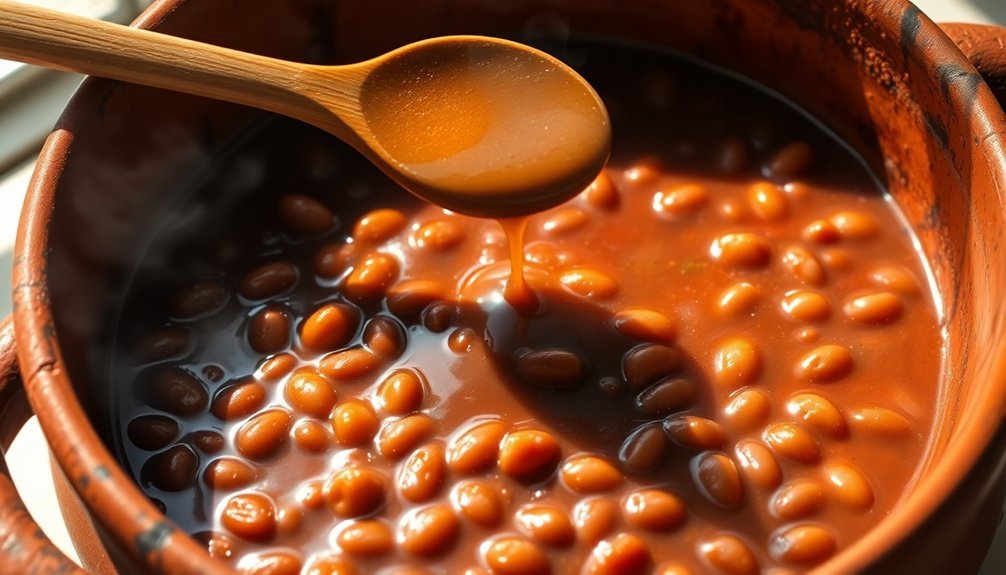When making sun-simmered bean stew, start with properly prepared beans – soak dried beans overnight and pre-cook them until tender, or thoroughly rinse canned beans before adding them to your pot. You'll want to build deep flavors by sautéing aromatics like onions and garlic in olive oil, then adding roasted cherry tomatoes, tomato paste, and warming spices like smoked paprika and cumin. To maintain the perfect consistency, simmer uncovered and stir frequently, adjusting the liquid levels with broth or water as needed. These fundamental techniques set the foundation for countless variations of this energy-efficient cooking method.
Perfect Bean Selection and Preparation

Three key factors make or break a sun-simmered bean stew: bean selection, preparation, and timing.
Your choice of beans will markedly impact the final texture and flavor of your stew. White beans like cannellini and great northern are excellent options, offering similar sizes and textures that cook evenly. You can also incorporate red beans or kidney beans for variety and depth of flavor.
Whether you're using dried or canned beans, proper preparation is vital. If you're working with dried beans, you'll need to soak them overnight and pre-cook them until tender.
For canned beans, make sure to drain and rinse them thoroughly before adding them to your stew. You'll want to adjust your liquid levels based on your chosen beans, as different varieties absorb moisture differently. Using 4 cups vegetable broth creates the perfect base for a hearty stew consistency.
Add your beans at the right moment to prevent them from becoming mushy. You can thicken your stew by reducing the liquid over time, stirring occasionally to guarantee even cooking.
Consider blending some of the cooked vegetables to create a richer, more complex texture. Remember to season throughout the cooking process to develop layers of flavor in your sun-simmered stew.
Building Layers of Flavor
Creating a rich, deeply flavored bean stew relies on thoughtfully layering ingredients and seasonings throughout the cooking process. Start by sautéing your aromatics – onions, garlic, and herbs – in olive oil until they're softened and lightly golden. This creates a flavorful foundation that'll infuse throughout your stew.
To build complexity, you'll want to incorporate various tomato elements. Roast cherry tomatoes to amplify their natural sweetness, and add tomato paste for richness and depth. White beans can be partially mashed to naturally thicken the broth while maintaining their creamy texture.
Don't forget the power of spices – smoked paprika introduces smokiness, while cumin adds earthiness. Red pepper flakes can provide a subtle heat that'll warm the dish without overwhelming it.
- Softened, golden onions releasing their sweet aroma into the oil
- Fresh herbs dancing in the pot, releasing their fragrant oils
- Cherry tomatoes bursting with concentrated sweetness
- Spices blooming in the heat, creating an enticing fragrance
- Steam rising from the pot, carrying complex layers of aroma
As your stew nears completion, remember to add finishing touches. A splash of vinegar will brighten the flavors, while a sprinkle of fresh herbs adds color and freshness.
Consider serving with crusty bread to soak up the flavorful broth.
Maintaining Ideal Stew Consistency

While achieving the perfect bean stew requires careful attention to flavor, maintaining the right consistency proves equally crucial for a satisfying result. You'll need to monitor your stew's thickness throughout the cooking process, making adjustments as needed to reach your desired consistency. Stirring in soy cooking cream creates a luxuriously smooth texture while adding richness to the dish.
To maintain ideal thickness, you can utilize several proven techniques. Simmering uncovered helps reduce excess liquid naturally, while adding thickening agents like flour or nutritional yeast provides immediate results. If your stew becomes too thick, simply add more broth or water. Conversely, if it's too thin, continue simmering or incorporate additional beans.
| Method | Effect |
|---|---|
| Uncovered Simmering | Reduces liquid gradually |
| Thickening Agents | Provides immediate thickness |
| Liquid Adjustment | Controls consistency precisely |
| Additional Beans | Increases natural thickness |
Keep checking your beans' tenderness while maintaining proper liquid levels. If you're using pre-soaked beans, they'll require less cooking time but still need monitoring. For best results, stir frequently to prevent sticking and guarantee even cooking. Consider adding creamy ingredients like coconut cream or cashew milk for enhanced texture while maintaining your desired consistency.
Frequently Asked Questions
Can I Cook This Stew Using a Solar Oven Outdoors?
Yes, you can cook stew in a solar oven outdoors. You'll need direct sunlight, proper preheating, and regular adjustments to maintain temperature. It's a great eco-friendly cooking method that works effectively.
What Alternative Proteins Can I Add Besides Beans?
You can add quinoa, tofu, mushrooms, or sun-dried tomatoes for protein variety. If you'd like meat alternatives, try soy-based products. Spinach and artichokes also pack surprising protein content to your stew.
How Do I Adjust Cooking Time at Different Altitudes?
At higher altitudes, you'll need to increase cooking time by up to 25%. For every 1,000 feet above sea level, add 5% more time. Keep food covered to prevent moisture loss during longer cooking.
Which Wine Varieties Work Best for Deglazing the Pot?
You'll get great results using Beaujolais for its light body and acidity, or dry whites like Chardonnay. If you're feeling adventurous, try Pinot Noir for contrast. Each adds unique depth while deglazing.
Are Ceramic or Metal Pots Better for Sun-Simmered Cooking?
You'll find ceramic pots are better for sun-simmered cooking as they retain heat longer, don't react with acidic foods, and emit far-infrared energy for even cooking, compared to metal pots.
In Summary
You'll find sun-simmered bean stew is a rewarding dish that's worth the extra attention to detail. By choosing and preparing your beans carefully, layering flavors strategically, and monitoring the consistency throughout cooking, you're guaranteed a hearty, flavorful result. Don't rush the process – let the sun do its work while you tend to the occasional stir and seasoning adjustment.





Leave a Reply